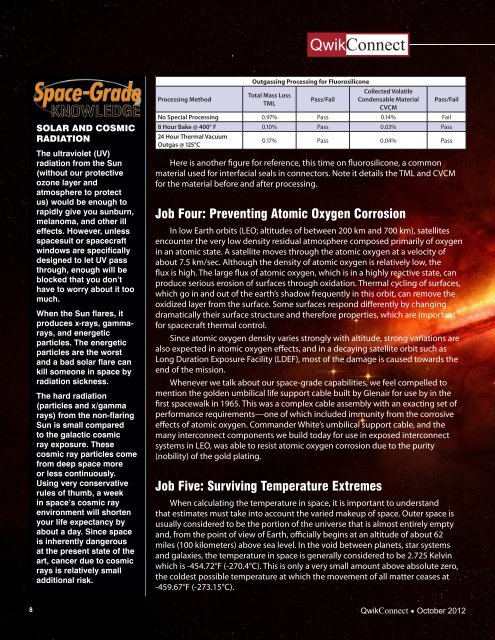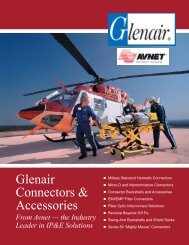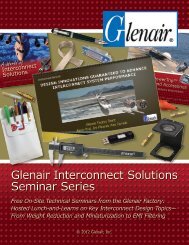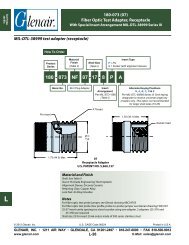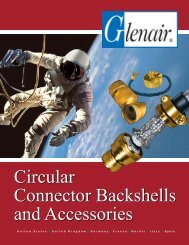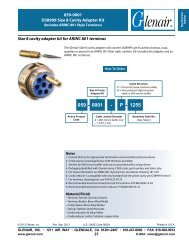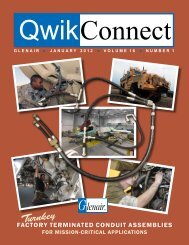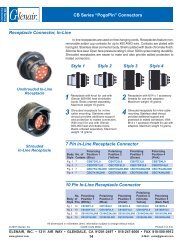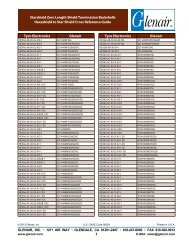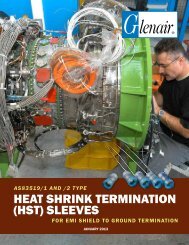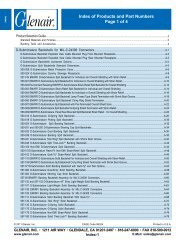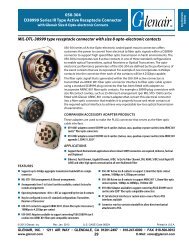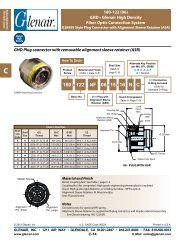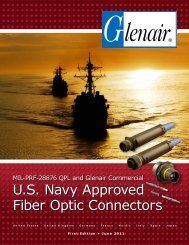Two page spread - Glenair, Inc.
Two page spread - Glenair, Inc.
Two page spread - Glenair, Inc.
You also want an ePaper? Increase the reach of your titles
YUMPU automatically turns print PDFs into web optimized ePapers that Google loves.
QwikConnect<br />
Outgassing Processing for Fluorosilicone<br />
Processing Method<br />
Total Mass Loss<br />
TML<br />
Pass/Fail<br />
Collected Volatile<br />
Condensable Material<br />
CVCM<br />
Pass/Fail<br />
SOLAR AND COSMIC<br />
RADIATION<br />
The ultraviolet (UV)<br />
radiation from the Sun<br />
(without our protective<br />
ozone layer and<br />
atmosphere to protect<br />
us) would be enough to<br />
rapidly give you sunburn,<br />
melanoma, and other ill<br />
effects. However, unless<br />
spacesuit or spacecraft<br />
windows are specifically<br />
designed to let UV pass<br />
through, enough will be<br />
blocked that you don’t<br />
have to worry about it too<br />
much.<br />
When the Sun flares, it<br />
produces x-rays, gammarays,<br />
and energetic<br />
particles. The energetic<br />
particles are the worst<br />
and a bad solar flare can<br />
kill someone in space by<br />
radiation sickness.<br />
The hard radiation<br />
(particles and x/gamma<br />
rays) from the non-flaring<br />
Sun is small compared<br />
to the galactic cosmic<br />
ray exposure. These<br />
cosmic ray particles come<br />
from deep space more<br />
or less continuously.<br />
Using very conservative<br />
rules of thumb, a week<br />
in space’s cosmic ray<br />
environment will shorten<br />
your life expectancy by<br />
about a day. Since space<br />
is inherently dangerous<br />
at the present state of the<br />
art, cancer due to cosmic<br />
rays is relatively small<br />
additional risk.<br />
No Special Processing 0.97% Pass 0.14% Fail<br />
8 Hour Bake @ 400° F 0.10% Pass 0.03% Pass<br />
24 Hour Thermal Vacuum<br />
Outgas @ 125°C<br />
0.17% Pass 0.04% Pass<br />
Here is another figure for reference, this time on fluorosilicone, a common<br />
material used for interfacial seals in connectors. Note it details the TML and CVCM<br />
for the material before and after processing.<br />
Job Four: Preventing Atomic Oxygen Corrosion<br />
In low Earth orbits (LEO; altitudes of between 200 km and 700 km), satellites<br />
encounter the very low density residual atmosphere composed primarily of oxygen<br />
in an atomic state. A satellite moves through the atomic oxygen at a velocity of<br />
about 7.5 km/sec. Although the density of atomic oxygen is relatively low, the<br />
flux is high. The large flux of atomic oxygen, which is in a highly reactive state, can<br />
produce serious erosion of surfaces through oxidation. Thermal cycling of surfaces,<br />
which go in and out of the earth’s shadow frequently in this orbit, can remove the<br />
oxidized layer from the surface. Some surfaces respond differently by changing<br />
dramatically their surface structure and therefore properties, which are important<br />
for spacecraft thermal control.<br />
Since atomic oxygen density varies strongly with altitude, strong variations are<br />
also expected in atomic oxygen effects, and in a decaying satellite orbit such as<br />
Long Duration Exposure Facility (LDEF), most of the damage is caused towards the<br />
end of the mission.<br />
Whenever we talk about our space-grade capabilities, we feel compelled to<br />
mention the golden umbilical life support cable built by <strong>Glenair</strong> for use by in the<br />
first spacewalk in 1965. This was a complex cable assembly with an exacting set of<br />
performance requirements—one of which included immunity from the corrosive<br />
effects of atomic oxygen. Commander White’s umbilical support cable, and the<br />
many interconnect components we build today for use in exposed interconnect<br />
systems in LEO, was able to resist atomic oxygen corrosion due to the purity<br />
(nobility) of the gold plating.<br />
Job Five: Surviving Temperature Extremes<br />
When calculating the temperature in space, it is important to understand<br />
that estimates must take into account the varied makeup of space. Outer space is<br />
usually considered to be the portion of the universe that is almost entirely empty<br />
and, from the point of view of Earth, officially begins at an altitude of about 62<br />
miles (100 kilometers) above sea level. In the void between planets, star systems<br />
and galaxies, the temperature in space is generally considered to be 2.725 Kelvin<br />
which is -454.72°F (-270.4°C). This is only a very small amount above absolute zero,<br />
the coldest possible temperature at which the movement of all matter ceases at<br />
-459.67°F (-273.15°C).<br />
NASA Astronaut Ed White made history on June 3, 1965, when he floated out of the hatch<br />
of his Gemini 4 capsule into the void of space for the first American spacewalk. White was<br />
attached to the capsule by a 25 foot umbilical cord, Manufactured by <strong>Glenair</strong>. The golden<br />
umbilical was displayed for more than a decade at the Smithsonian National Air and Space<br />
Museum in Washington, DC.<br />
Measuring the temperature in space is more complicated than just using a<br />
thermometer, since temperature is only a meaningful figure when heat can be<br />
efficiently transferred from one body to another. In space, while the temperature<br />
of particles can be very high, their density is very low so the ability to transfer heat<br />
is minimal. They could be at millions of degrees in the Kelvin range, but since they<br />
so rarely collide with one another, the actual phenomenon of temperature or heat<br />
exchange doesn’t takes place. The temperature in space therefore has to do with the<br />
movement and concentration of the molecules, which in turn determines how often<br />
they collide with one another to gain or lose energy.<br />
Due to this phenomenon, the temperature must be determined using Planck’s<br />
law, which says that every object in the universe emits radiation according to its<br />
temperature. By looking at the radiation emitted from space and using this formula,<br />
scientists have found that the temperature is about 2.725 K. Different parts of space<br />
actually have different temperatures, and the Milky Way galaxy — where the Earth is<br />
located — is slightly warmer than many other areas.<br />
Designing interconnects for space requires an in depth understanding of<br />
peak temperature and cycling stress in metal, glass and polymer materials. The<br />
combination of temperature extremes and other stress factors, such as corrosion,<br />
can also lead to performance degradation and must be accounted for in designs<br />
and material selections.<br />
SHOOTING STARS<br />
How are shooting stars<br />
made and how often do<br />
they occur during the<br />
night<br />
There are many little<br />
chunks of rock present in<br />
space. Their sizes range<br />
typically from the size of<br />
a grain of dust to the size<br />
of a golf ball (the latter<br />
being more impressive<br />
in the night sky, but also<br />
more rare). As the Earth<br />
moves around the Sun,<br />
its atmosphere runs into<br />
some of these small rocks<br />
at great velocities. Going<br />
through the atmosphere,<br />
the rocks begin to heat<br />
up, start to glow, and<br />
then burn up. This is<br />
what we see when we<br />
look at a shooting star<br />
(which we call a meteor).<br />
Anything above a few<br />
kilograms should make it<br />
to the ground, depending<br />
on the composition.<br />
There are millions of<br />
particles colliding with<br />
the atmosphere every<br />
day. But since you can<br />
only see them at night,<br />
and you can only look at<br />
a small part of the sky at<br />
once, when stargazing<br />
you can expect to see a<br />
shooting star every 10 to<br />
15 minutes.<br />
8 QwikConnect • October 2012<br />
QwikConnect • October 2012<br />
9


